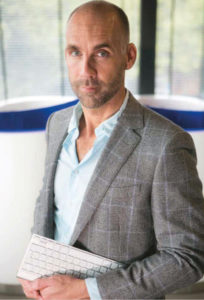Text: Robert Eel | Picture: Roel Dijkstra
The banking landscape is changing rapidly. Technological developments have changed the playing field has been changed by technological developments and banks have to compete with new parties and ‘DIY-ing’ consumers. Innovation is needed here, but according to international keynote speaker Richard van Hooijdonk, banks are not equipped for this. He advocates banking innovation that is separate from the daily routine. Download the complete interview here. Does the jacket need to be closed for the photo? “Please, no”, Van Hooijdonk says resolutely. “I really don’t want to look like a banker.” But the roots of this international speaker/entrepreneur do lie firmly in the banking world and he regularly meets with bankers to advise them on innovation, media and marketing. “I call it ‘monkey see, monkey do’ behavior. No matter which bank or boardroom you enter, everybody looks the same. When leaders and employees of a company feel compelled to conform to implicit dress codes it says a lot about the level of innovation at that company. A company such as Google shows that an informal work atmosphere is conducive to increasing creativity. Companies and people are not naturally inclined to innovate; they mostly prefer doing what others do. Companies are generally not very keen on employees who do things differently but prefer people who do the same thing day after day. And we are very happy to do just that, every day, from 9 to 5. However, innovation only really works if you do things in a countercyclical manner, differently from others.”
Crisis provides safety
The argument that many Dutch banks have been primarily concerned with survival in the past six years doesn’t impress Van Hooijdonk very much. “I really do have a lot of respect for the way CEO’s have steered their banks through and out of the crisis, but crisis also offers security. The Compliance department controls the organization, primarily focusing on how not to do it.”
He advocates separating innovation from the going concern within the bank. In his opinion, when searching for innovation, directors are held back by ballast from the past and this ballast is anchored within the employees. “There are black bears, brown bears and white bears in every organization. Black bears enjoy making your life miserable and can’t or won’t move aside. The brown bears are mostly anxious and afraid of human 3.0, who is quite assertive and wants to co-create. That fear can also inspire people however, because remember how afraid we were in 1850 about trains causing all kinds of calamities? The white bear thinks you are fantastic and there’s no need to convince him. There’s nothing wrong with banks appointing Chief Innovation Officers now, but this only works if these people come from outside, not from within the banking world.”
Van Hooijdonk says that banks, the way we know them now, will disappear within ten to fifteen years. “That is largely due to the fact that banks can no longer count on the citizens’ trust. They think bankers are scammers. Although I do feel that some discussions, such as those around bonuses, are incredibly hyped up by the press. There may be very legitimate reasons for bonuses but the negative connotation lingers on.”
Life Coach
According to Van Hooijdonk, to regain that trust, banks need to start fulfilling core roles within the modern family and within the modern company. “They should become a kind of life coach, be good to people in a transparent and honest way. To accomplish this, you don’t need advisory offices, but access to the client online. The new bank customer is made for that. But if you want to get that customer’s attention, you will need to offer them something interesting, something more than the current model, to be precise. Currently, banks mainly offer commodities. But facilitating financial transactions and offering some insurance and investment products only will no longer do the trick. The margins are too small for that. In the new world you need to be there during moments that matter to your customers, for instance when someone changes jobs and needs advice about pension. If you, the bank, start focusing on moments like these and start connecting with your customer, he will also trust you with the commodity services. To achieve this, an entirely different bank is needed: a different mindset and a different culture.” Within this new approach, ‘flat’ advertising is not very useful, according to Van Hooijdonk. The future lies in native advertising; the sharing of knowledge and ideas – content – something that is of value to the customer, delivered via the new media channels the customer uses. “That’s how thought leadership is created. Consumers really don’t fall for transparent advertising anymore. If, in a TV commercial, the bank asks how things are going with your home, he actually means ‘come and let us handle your mortgage’. The bank needs to become a human brand that really matters to the customer.”
According to Van Hooijdonk, this is why banks need to change everything. Not just the products but things like behavior, service delivery and language as well. “Throwing a bomb on the existing bank and building a new one on the ruins would be best”, says Van Hooijdonk in a semi-serious tone of voice. Smiling: “But of course, that is not easily done. A very different, but certainly achievable option is to build a new bank next to the existing bank. That way, you can still be open for business, albeit with the inevitable further shrinkage. At the new bank, with employees especially selected for the purpose, you can start the innovation that produces growth of revenue. I think it makes sense to then explicitly look for staff from outside the bank. A good example is Staples, the office supplies wholesaler, who recently managed to acquire Bol.com’s sales director. As an ageing company, getting someone from one of the largest online fast movers on board will definitely accelerate your innovation process.”
Current initiatives for innovation in the banking world are not particularly innovative, Van Hooijdonk says. As far as he is concerned, the same thing goes for Knab, the young bank that, from the outset, indicated they wanted to do things completely differently. Days after the interview, Knab launched a new functionality within their app that would enable customers to transfer money via Facebook, without a bank account. Van Hooijdonk: “I certainly have appreciation for someone like René Frijters, but we’re still dealing with innovation from a straitjacket. Banking via a Facebook app is nice, but Knab is still a bank. I have the feeling that we are still messing around, while there is a need for a new type of bank that is not afraid to be disruptive. Take the Square app and its reader which enables you to prepare your mobile phone or tablet for credit card payments. Or Uber, which enables you to order a taxi with just one push of a button on your mobile phone, without using a taxi company. Those are the type of innovations that significantly interfere with existing business models.”
Disruptive innovator
In his own perception, Dirk Scheringa was a very innovative banker. In the beginning of this century, Van Hooijdonk worked several years as marketing director at DSB. Three times over he received the ‘Loden Leeuw’, an award handed out during TV program Tros Radar, for the company with the most annoying TV commercials. Van Hooijdonk smiles. “Whatever you may think of him, Scheringa was most definitely a disruptive innovator; he wanted to shake up the market. I left the company in 2005, by the way, because I didn’t agree with a number of things, but besides that I wanted to leave anyway because three to four years at one company is long enough for me.”
DSB is not the only bank where Van Hooijdonk worked as marketing manager. At the end of the nineties he also worked for Bank Labouchère (Aegon), well known for their Legio-Lease product ‘De Winstverdriedubbelaar’ (The profit trippler). “Of course a few things went wrong in that period. Nobody had heard of Compliance in those days; and providers tried to push the boundaries with their products. Nowadays we see this as a bad thing and rightly so, but does that relieve consumers of their duty to be critical thinkers? Come on. Before buying a second hand car, you put it on the bridge to have it checked. Why should that be different when you buy a complex financial product?”
Clever bank executives
“Compliance is currently much more of an issue within banks, and rightly so. But it is also high time to switch gears and work towards disruptive innovation. Only then will banks have a chance of survival.” He points out technological developments that are taking place in other parts of society, such as experiments with digital law. Or the emergence of robots – “already with an IQ of 38” – that will start taking over certain human tasks, including the authority to make decisions. “That’s the kind of world we’re moving towards.” It explains the large black plastic horse standing in the business lounge. “There was a time when people feared cars because it meant horses would be job-less. But that car came anyway, in the same way we will be moving from car to self-driving car and from self-driving car to robot.
In 2025 we will have access to five times more data than now and the algorithms required to deal with these volumes will also become smarter. When you take into consideration that ordinary businesses need three to five years to change, you will understand that banks will need five to ten years. So as a bank, you better start immediately; all you need is guts! Bank directors are clever. They look for direction but they need to make sure their organization is on the same page.”
Share via:




